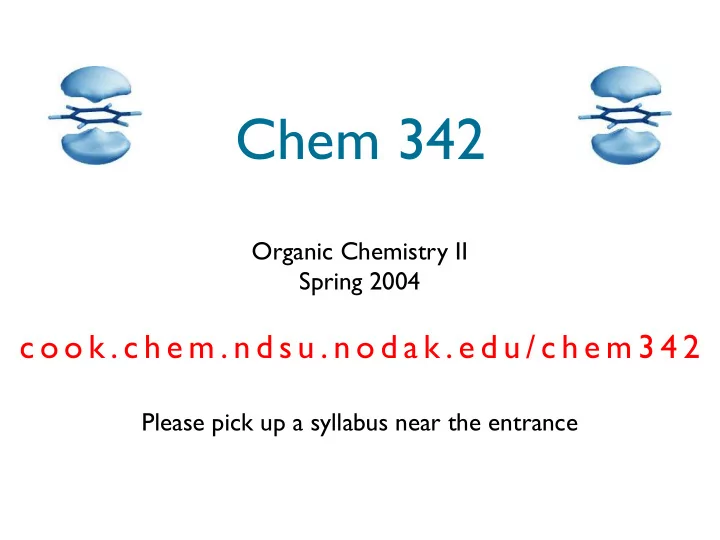

Chem 342 Organic Chemistry II Spring 2004 c o o k . c h e m . n d s u . n o d a k . e d u / c h e m 3 4 2 Please pick up a syllabus near the entrance
Syllabus Office Hours Mon, Wed - 9:00-10:00 am or give me a call Dunbar Hall 360A Phone - 231-7413 Email - gregory.cook@ndsu.nodak.edu AIM/iChat - gregcook@mac.com 2
Grading 500 point scale three 100 point midterm exams a 200 point comprehensive final Quizzes Six 21 point quizzes Top 5 quizzes will be added for total of 105 potential points If higher, this will automatically replace your lowest midterm exam score 3
Grading A 85-100% B 75-84% C 60-74% D 45-59% 4
Web Page c o o k . c h e m . n d s u . n o d a k . e d u / c h e m 3 4 2 5
Course Outline NMR Spectroscopy Conjugated Dienes Aromaticity - Chemistry of Benzene Alcohols and Phenols Ethers and Epoxides Carbonyl Chemistry Amines Biomolecules 6
Course Content Functional group chemistry General Properties Reactions Why is this important? 7
My Philosphy Toward Organic Chemistry Like a foreign language Vocabulary Terms Structures Functional Groups Grammar Electronic properties Reactivity 8
Tips For Learning Organic Chemistry Read ahead before coming to class COME TO CLASS Rewrite your notes Do the suggested problems - do them again Flash cards can help REAGENTS SUBSTRATES PRODUCTS 9
Tips For Learning Organic Chemistry Study with a friend or form a study group A set of molecular models can help DON’T Fall Behind DON’T Fall Behind DON’T Fall Behind Organic Chemistry is an integral part of Biology and Biochemistry. Life exists because of Organic Chemistry. 10
Chapter 13 - NMR Spectroscopy Basis of NMR How functional groups affect NMR How protons affect nearby protons How to interpret NMR and assign structure 11
How to determine the structures of molecules? Probe physical properties Elemental Analysis atomic composition (relative ratios) empirical formula Mass Spectrometry molecular formula element identification (isotopes) connectivity 12
How to determine the structure of molecules? Vibrational (Infrared) Spectroscopy functional groups Electronic (UV-VIS) Spectroscopy conjugation X-Ray Crystallography 3D positions of atoms 13
NMR Spectroscopy Atom Connectivity Functional Group Identification Stereochemistry Higher Order Structure 14
Identification of a Natural Product High Res. Mass Spectrometry Cl H N 37Cl 210.0764 4.4% C11H13N2 N 35Cl 208.0769 15.5% C11H13N2 Epibatidine J. Am. Chem. Soc. 1992 , 112 , 3475 UV Spectroscopy Isolated from the Ecuadorian tree 217 nm and 250-280 nm indicates frog - Epibatis Tricolor pyridine ring Analgesic activity 500 times greater than morphine. IR Spectroscopy 1428 and 1112 cm-1 suggests a pyridine ring 15
Proton NMR Cl H N N Epibatidine J. Am. Chem. Soc. 1992 , 112 , 3475 16
Carbon NMR Cl H N N Epibatidine J. Am. Chem. Soc. 1992 , 112 , 3475 17
NMR Phenomenon Nuclear Magnetic Resonance A spinning charged particle generates a magnetic µ field. A nucleus with a spin angular momentum will generate a magnetic moment ( μ ). If these tiny magnets are placed in an applied magnetic field ( B o ), they will adopt two different states - one aligned with the field and one aligned against the field. The energy difference between these two states is what we are observing with NMR. B 0 18
Nuclear Spin States aligned against B 0 Energy difference between the states at a particular magnet E strength. In the R f range of the EM Spectrum. aligned with B 0 B 0 When EM waves at this energy are directed at the nuclei - it will absorb. Spins will flip from lower energy to higher energy. At that energy, nuclei are “In Resonance”. 19
NMR Active Nuclei Many nuclei are “NMR Active” Spin Quantum Number I ≠ 0 1 H -- I = ½ ; 13 C -- I = ½ 12 C, 16 O -- I = 0 -- Can’t be observed Other nuclei that are NMR active 2 H (D), 14 N, 19 F, 31 P 20
NMR Instrumentation 21
Magnetic Resonance Imaging NMR is the basis for MRI 22
Recommend
More recommend